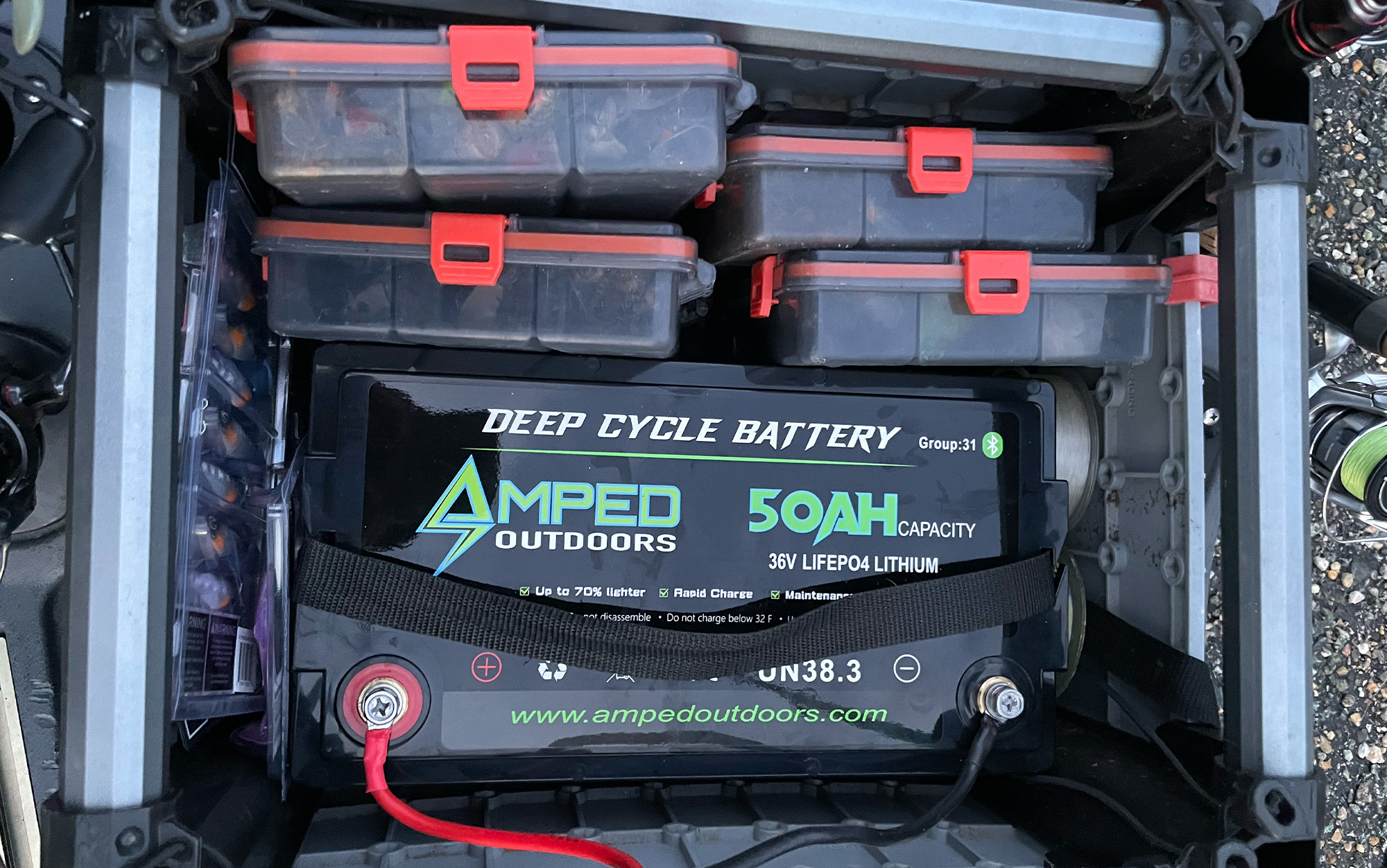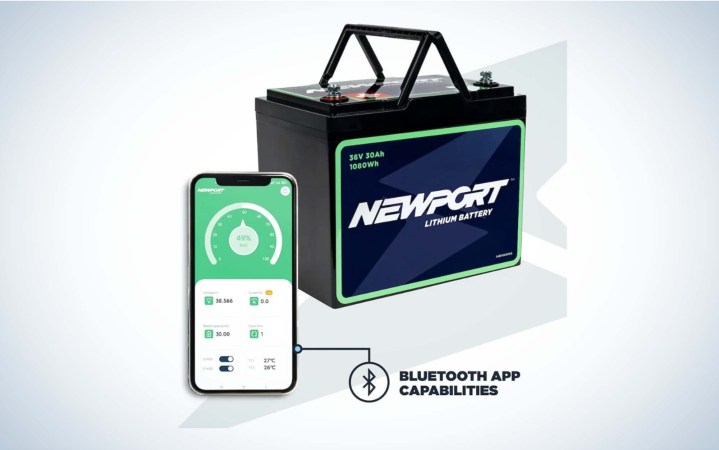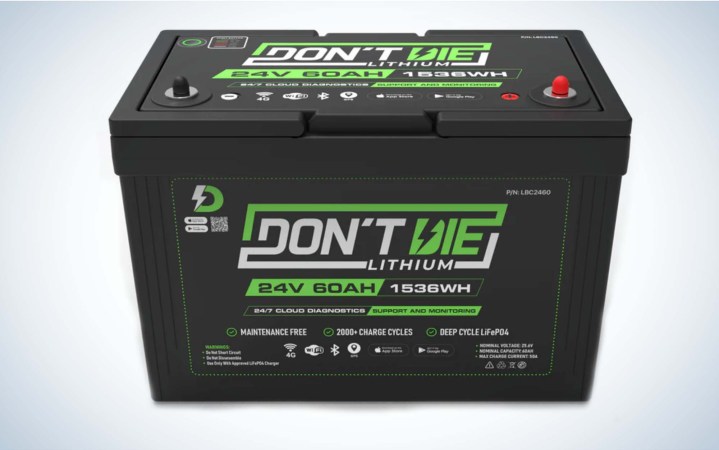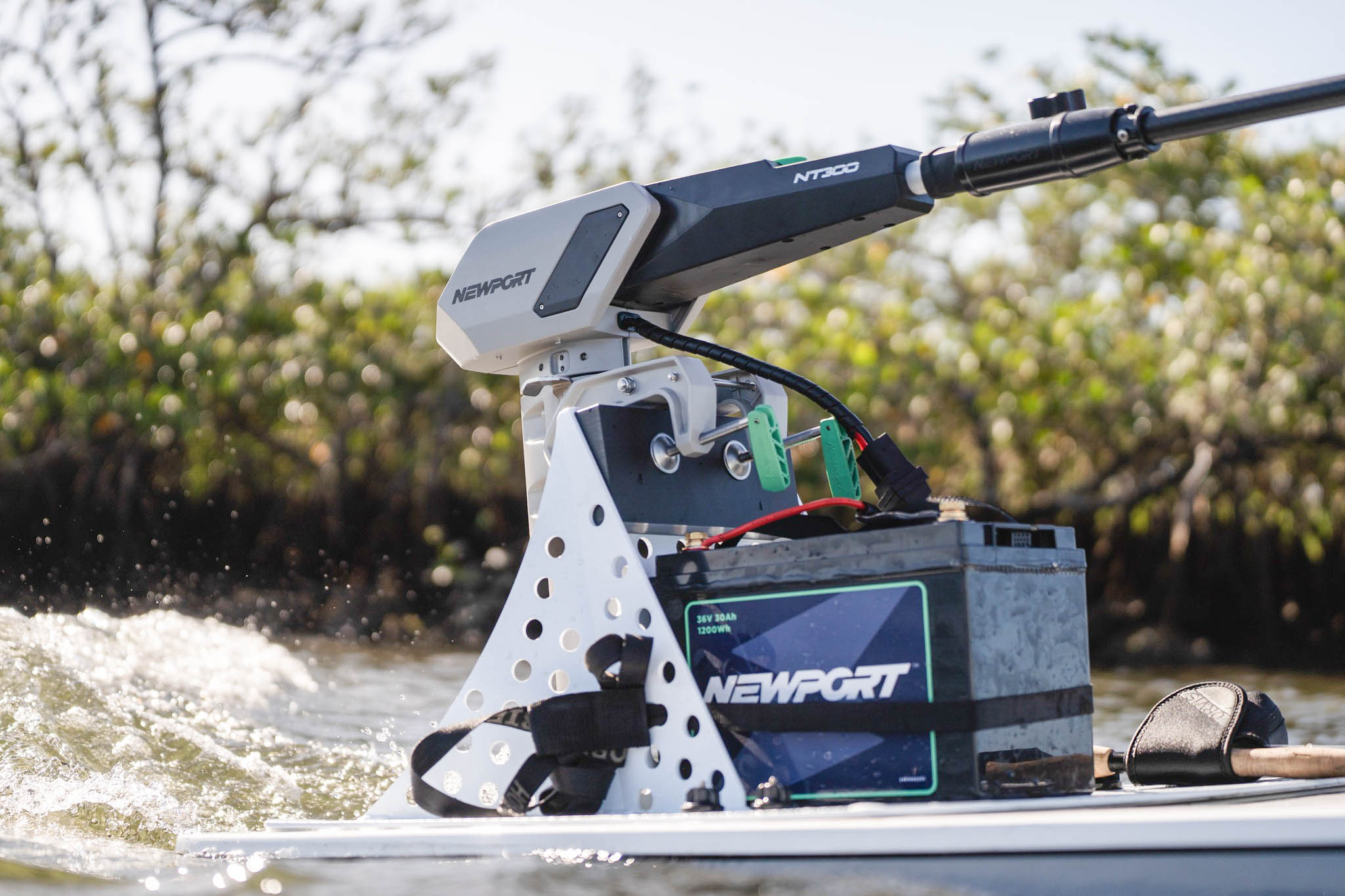We may earn revenue from the products available on this page and participate in affiliate programs. Learn More ›
Choosing the best battery for your boat used to require relatively few brain cells or discretion, as there were few choices. That led many anglers and boaters to take a defeatist attitude—they’d choose the cheapest one, believing that just about all of them would die prematurely, so they factored a replacement (or multiple replacements) into the calculus. That’s no longer a wise tact. Not only are there exponentially more specialized choices, but also different needs for every boat.
Say, for example, you use a small kayak or canoe. A 90-pound lead battery will take up space and compromise maneuverability, so size and weight may be your main considerations. Meanwhile, someone running three or four 12-inch graphs and a livewell all day needs max power. Add into this the proliferation of lithium options, and batteries can do more with less (weight) than ever before and maintain their strength for more cycles, but all of that comes at a cost.
Figure out what you need, what you can afford, and then consider stepping up to your max range. Sure, those cheapo batteries get replaced numerous times for the cost of the more premium models, but that doesn’t help you when you’re 30 miles up the lake or out at sea. It also can’t give you back the lost time. Batteries may not be as sexy as high-tech graphs or a new trolling motor, but those two accessories—and many others—are useless without them.
How I Chose the Best Marine Batteries
For years it was almost a parlor game among boaters to see who could get the most while spending the least—with a side hustle of complaining about how quickly their batteries went down. Now most of us have wised up, and buy purpose-driven power sources with less regard (but not none at all) for cost. With more options, though, it’s easy to overspend.
I’ve gone from lead acid to AGM to a combination of AGM and lithium batteries in my boats. That last step was a tough one, because it required a four digit outlay to get properly outfitted. The nice thing in this case was that not only do I have more power, but it takes less weight to get there. Your equation may not have the same variables, but it’s nice to know that there are ample choices, and some very good ones, at just about every price point. I used my experience trying various batteries with over a decade of boat ownership to make my choices for the best marine batteries.
Best Marine Batteries: Reviews & Recommendations
Best All-in-One: Lithium Pro TM3165-36
See It
Key Features
- Group 31 size
- Replaces three 12V batteries
- 42.9 pounds
Pros
- Lightweight
- Bluetooth connectivity
- Easy-to-use QuickView map
Cons
If your bilge compartment is crowded, or the rear end of your boat suffers during holeshot, you won’t know what to do with the extra space or the extra oomph during takeoff after replacing your batteries with the Lithium Pros. You’ll remove hundreds of pounds of weight while also getting more power and longevity. This three-in-one solution can be charged over 3,000 times without losing effectiveness and they’re super-advanced. After downloading the QuickView App, you’ll be able to instantly know exactly how much power is left. They’re costly, but if you value space and effectiveness, it may be a worthwhile tradeoff.
See It
Key Features
- Four sizes
- 38 to 59 pounds
- 10 to 155 minutes reserve capacity
- Maintenance free
Pros
- Can be mounted in almost any position
- Resistant to vibration
- Smaller footprint than many comparable batteries
Cons
- Easy to mount, but not light for its size
The Optima was the first “premium” battery to attract a wide swath of recreational boaters, capturing their attention with its atypical, colorful looks, and earning their loyalty with long-lasting performance. It comes in a variety of sizes and strengths and is particularly attractive if you have limited space to mount it, as it has a small footprint and can be mounted in virtually any position. They’re also readily available from wide variety of sources, so if you do run into an issue it can be taken care of pronto.
Best Budget: Interstate Deep Cycle Batteries
See It
Key Features
- Numerous configurations in 24, 27, and 31 footprints
- Proven wet cell construction
- 24 month free replacement
Pros
- Very affordable
- Widely available
- Proven technology
Cons
- Not as powerful as some more updated batteries
The green top Interstates are available at marine dealers, tackle stores, and automotive shops everywhere and they’ve stood the test of time, powering everything from one-man molded boats to Bassmaster Classic winners for decades. They feature simple and proven technology. Without any bells or whistles there’s little to go wrong. Find the one that fits your needs, keep it hydrated, and it’ll keep you going for years on a budget.
See It
Key Features
- Sizes 24, 27, and 31
- Molded in offset posts
- Stainless steel studs and wing nuts
- 12-month warranty
Pros
- Time-tested design
- Plenty of reserve capacity
- Easy to install and set up
Cons
I ran Dekas for years because they were easy to find and always seemed to exceed my expectations. In fact, while I typically planned to replace them every three to four years, oftentimes they were still at near 100 percent abilities at that point, and the only reason I swapped them out was fear that I was taking my chances. I don’t believe I ever ran one of their lead acid batteries to its death. They’re readily available through all sorts of marine dealers, auto parts stores, and even hardware big boxes, so if you do run into a problem, a replacement is never far away. You can get cheaper batteries in this category, but several of the best known have crapped out on me, and I’d bet my best day on the water on this cost-effective option.
See It
Key Features
- Small footprint, approximately 6 x 2.5 x 4 inches
- Less than 3 pounds
- Works in extreme temperatures
- Standard F2 terminals
Pros
- Extremely lightweight
- Flat voltage curve
- Up to 80 percent capacity for 2,000 cycles in recommended conditions
Cons
- Not ideal for powering multiple hungry accessories outside of the kayak venue
Dakota Lithium’s kayak-sized 12 volt batteries may not be able to handle three big graphs and a livewell, or cranking up a 250-horse outboard, but they do what they’re meant to do perfectly and without obstructing your range of motion or slowing you down. They’ll easily power kayak fish finders and trolling motors. They’re ideal for squeezing into any small boat, including but not limited to kayaks, and then forgetting about them. The last longer and weigh less than a lead acid battery, and have an 11-year warranty against manufacturer defects. Put one in your small boat and prepare to have more power than you need.
Best Long Range Kayak Battery: Amped Outdoors 36V 50Ah Trolling Motor Lithium
See It
Key Features
- 36 volts
- Weight: 38.3 pounds
- Bluetooth capability
- 10-year warranty
- 50AH (55AH actual capacity)
- Discharge Cut-Off: 20V
- Charge Cut-Off: 43.8V
- Charge Current: 50A Max
Pros
- Extremely long lasting
- IP67 waterproof
- Simple to use
- Bluetooth enabled monitoring
Cons
The Amped Outdoors 36V 50aH lithium battery is longer lasting than the average kayak motor battery, while also being the lightest in its class. Kayak angler Aliex Folgueira has been running a Newport Vessels NK300 kayak motor off this battery for some time, estimating that he’s run over 40 miles at 40 percent power on a single charge. This blows away the standard range on most traditional kayak motor batteries, which usually average between 10-20 miles under similar circumstances. Sure, it’s roughly 10 pounds heavier than a standard battery, but that’s a fair trade for the extended range and additional power this battery provides.

Kevin Hughes
While somewhat larger than other kayak batteries, it still fits nicely in kayak crates like the Hobie H-crate and YakAttack Black Pack Pro. In addition to its added power, it has several features that ensure it stays charged when it should and doesn’t cutoff when it shouldn’t. With a charge cut-off of 43.8V and discharge cut-off of 20V, along with short circuit protection of 220A, this battery stays functioning as intended throughout long days on the water. Ultimately, the peace of mind and extended range this battery offers more than make up for the additional few pounds it adds to the boat. —Kevin Hughes
Best AGM Battery: Pro-Guide AGM
See It
Key Features
- 24, 27, and 31 sizes
- 24 month replacement
- Up to 500 cycles at 80 percent depth of discharge
Pros
- Less expensive than lithium
- Can be discharged 500 times with no appreciable loss of power
- Maintenance free
Cons
These batteries are knuckle busters if you need to remove them from a tight bilge compartment, but the good news is that you won’t have to do so for a long time. I found that out the hard way when my 4-year-old propeller threw a blade six miles from the ramp. I fished my way back with the trolling motor at a pretty fast clip and still had more than enough juice to spare when I got to the dock, so of course, I fished some more. Pro Guide is a smaller company, so they may not get the press of some others, but everything they make has been exceptional. I’m tough on batteries by using crappy hotel power sources, fishing late in to the evening, and driving in rough water, but nothing I can do seems to take a toll on these AGMs. If you have some reason not to move up to lithiums, this is the next best thing, and it’s proven technology.
Best Budget AGM: Bass Pro Shops Power Series Deep-Cycle AGM Marine Battery
See It
Key Features
- Sizes 22, 24, and 31
- Dual purpose starting and deep cycle
- Maintenance free
Pros
- Can be used for both cranking and deep cycle purposes
- Vibration and impact resistant
- Set it and forget it
Cons
If you want a little bit more power and performance than a lead acid battery, and you’re willing to pay for it, but not for lithiums, then an AGM is your best bet. These are widely available and effectively require no maintenance. They’re heavy, but you’re getting value in all of those pounds. You also get the proven imprimatur of Bass Pro Shops behind them – that includes a really good warranty if something should go wrong, although you almost certainly won’t. They have lots of power and you can mix and match them for both starting and deep cycle purposes. Hook multiple tools up and prepare to fish hard, because there’s a lot of bang for your buck in these compact but heavy packages.
Best High-Tech Lithium Battery: Newport Bluetooth Lithium Battery

See It
Key Features
- 24 volt and two 36 volt options
- Integrated charging circuitry
- Bluetooth monitoring
- All less than 30 pounds
Pros
- Worth with both iOS and Android systems
- Water-resistant design
- Reasonably priced for lithium
Cons
- Price may be more than some boaters can bear
Increased power demands mean that anglers constantly live in fear of being unable to operate their accessories or, worse yet, getting stuck. Newport handles that by pairing an easy-to-use app with a battery management system. The latter not only reports back on how much power is available, but also optimizes performance. That means more time on the water using all of your power-sucking accessories. Extremely short charging times enhance that benefit. If you want more time on the water but also constantly need to know what you have in reserve, this is your best choice. It also comes with a five-year warranty, so if the cost may be a deterrent, that should provide a certain level of comfort.

See It
Key Features
- 36 volt options of 50AH, 60AH and 120AH
- Ultra lightweight
- Bluetooth, Wi-Fi, and Cellular
Pros
- 11-year warranty
- Over 2,000 charge cycles expected
- All under 35 pounds
Cons
- Might be more than most boaters need
The first Space Shuttle may not have had as much computing power as this new lithium battery, and if you have the bucks and your livelihood depends on constant reliable power, then it may be a wise investment. With optional Wi-Fi connectivity and 4G cellular service, you can truly trick it out, but even the most “basic” versions come with a matching Bluetooth app to keep you constantly informed. There are also automatic firmware updates, a reset button that precludes the need for jump starts, and 24/7 technical support and cloud monitoring of all functions. In the highly unlikely case that something goes wrong, it’s probably operator error more than anything. There’s even GPS tracking so if someone steals your batteries, or the boat they’re mounted in, the authorities can track them.
Things to Consider Before Buying a Marine Battery
Purpose
Different batteries do different things well. For example, a cranking battery provides short bursts of heavy-duty power, while a deep cycle battery gradually discharges with small expenditures. There are dual purpose options but don’t get something that compromises on all fronts. Figure out what you need it for and buy the tool that’s built for that task.
Power Needs
The right type of battery is a good starting point, but you’ll have to figure out how much juice you’ll need to generate, whether in quick bursts or over a longer period of time. If you go for the bare minimum, expect to be let down. Assume that some power is lost in transmission, too, so make sure that you have the proper types of connections and wire of an adequate gauge.
Budget
There are still sub-$100 batteries out there that are good for some purposes and ideal for some users, but with newer lithium models extending up into the thousands, it’s easy to stretch your wallet. Remember, there’s not just the initial cost, either. If you have to replace them every year while others last 10 years, there’s the convenience factor plus replacement costs. Don’t forget to factor in the proper charger, either. Different types may require altogether different units — failure to use the right one can damage or undercharge your power plants.
Space Constraints
The space available on a center console is likely far different than that on a canoe or kayak, as are the power needs. Even within the same class of craft, however, all battery compartments are slightly different. You’ll want to be able to get to your batteries for easy rigging or replacement, and mount them in a safe and secure position, because a 60-pound hunk of lead flying around your bilge compartment in 6-footers is not a good situation.
FAQs
To maintain a marine battery, keep the connections clean, fully charge it, and keep your battery box dry with good ventilation.
Lithium batteries are more expensive, but they are also lighter and more compact that lead acid.
Final Thoughts on the Best Marine Batteries
Whether you need the best marine battery with features like app connectivity, or a budget-minded lead acid option, one of the above marine batteries will keep your boat and electronics running for years.
Read the full article here




